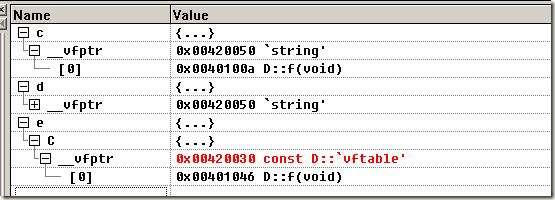多态是面向对象的基本特征之一。而虚函数是实现多态的方法。那么virtual function到底如何实现多态的呢?
1 基类的内存分布情况
请看下面的sample
class A
{
void g(){.....}
};
则sizeof(A)=1;
如果改为如下:
class A
{
public:
virtual void f()
{
......
}
void g(){.....}
}
则sizeof(A)=4! 这是因为在类A中存在virtual function,为了实现多态,每个含有virtual function的类中都隐式包含着一个静态虚指针vfptr指向该类的静态虚表vtable, vtable中的表项指向类中的每个virtual function的入口地址
例如 我们declare 一个A类型的object :
A c;
A d;
则编译后其内存分布如下:
从 vfptr所指向的vtable可以看出,每个virtual function都占有一个entry,例如本例中的f函数。而g函数因为不是virtual类型,故不在vtable的表项之内。说明:vtab属于类成员静态pointer,而vfptr属于对象pointer
2 继承类的内存分布状况
假设代码如下:
public B:public A
{
public :
int f() //override virtual function
{
return 3;
}
};
则
A c;
A d;
B e;
编译后,其内存分布如下:
从中我们可以看出,B类型的对象e有一个vfptr指向vtable address:0x00400030 ,而A类型的对象c和d共同指向类的vtable address:0x00400050a
3 动态绑定过程的实现
我们说多态是在程序进行动态绑定得以实现的,而不是编译时就确定对象的调用方法的静态绑定。
其过程如下:
程序运行到动态绑定时,通过基类的指针所指向的对象类型,通过vfptr找到其所指向的vtable,然后调用其相应的方法,即可实现多态。
例如:
A c;
B e;
A *pc=&e; //设置breakpoint,运行到此处
pc=&c;
此时内存中各指针状况如下:
可以看出,此时pc指向类B的虚表地址,从而调用对象e的方法。
继续运行,当运行至pc=&c时候,此时pc的vptr值为0x00420050,即指向类A的vtable地址,从而调用c的方法。
这就是动态绑定!(dynamic binding)或者叫做迟后联编(lazy compile)。
为了更加透析多态的原理,我们可以debug 程序在runtime时候的对象内存分布情况。
以下面这段简单的程序为例
//
#include "stdafx.h"
class Base
{
public:
int m_data;
static int m_staticvalue;
Base(int data)
{
m_data=data;
}
virtual void DoWork()
{
}
};
class AnotherBase
{
public:
virtual void AnotherWork()
{}
};
class DerivedClass:public Base,public AnotherBase
{
public:
DerivedClass(int t_data):Base(t_data)
{}
virtual void DoWork()
{
}
virtual void AnotherWork()
{
}
};
int Base::m_staticvalue=1;
int main(int argc, char* argv[])
{
DerivedClass b(1);
b.DoWork();
return 0;
}
当程序运行后我们设置很简单的breakpoint: bp simplestack!derivedclass::dowork. 断点命中后的call stack如下:
0:000> kb
ChildEBP RetAddr Args to Child
0012ff20 0040102a 00daf6f2 00daf770 7ffd7000 SimpleStack!DerivedClass::DoWork
0012ff80 004012f9 00000001 00420e80 00420dc0 SimpleStack!main+0x2a
0012ffc0 7c817077 00daf6f2 00daf770 7ffd7000 SimpleStack!mainCRTStartup+0xe9
0012fff0 00000000 00401210 00000000 78746341 kernel32!BaseProcessStart+0x23
这时,我们可以看看DerivedClass对象的内存内分布情况:
0:000> dt SimpleStack!DerivedClass 0012ff74
+0x000 __VFN_table : 0x0040c020 //指向虚表的指针1
+0x004 m_data : 1
=0040d030 Base::m_staticvalue : 1 //(类成员)
+0x008 __VFN_table : 0x0040c01c //指向虚表的指针2
可以看到,DerivedClass对象中包含两个指向虚表的指针,地址分别为0x0040c020 和0x0040c01c 。一个为指向override了BaseClass的方法的虚表,一个指向orverride了AnotherBase方法的虚表。
可以查看对应虚表中的方法:
0:000> dds 0x0040c01c
0040c01c 00401140 SimpleStack!DerivedClass::AnotherWork
0040c020 00401110 SimpleStack!DerivedClass::DoWork
0040c024 004010e0 SimpleStack!Base::DoWork
0040c028 004011a0 SimpleStack!AnotherBase::AnotherWork
......
通过以上分析,应该可以透析多态的本质了。
这种看内存分配方案真的不错的,^-^
自己也试了一下,虽然常用VC,不过也没注意过
#include <iostream>
using namespace std;
class base2
{
public:
virtual std::string ff(){return "base2";}
protected:
private:
};
class base
{
public:
virtual std::string f1(){return "base";}
virtual std::string f2(){return "base";}
virtual std::string f3(){return "base";}
protected:
private:
};
class child : public base , public base2
{
public:
virtual std::string f2(){return "child";}
virtual std::string f3(){return "child";}
protected:
private:
};
class grant : public child
{
public:
virtual std::string f3(){return "grant";}
protected:
private:
};
void main()
{
base a;
child b;
grant c;
string sa = a.f1();
string sb = b.f1();
string sc = c.f1();
}
// 内存状态
- a {...}
- __vfptr 0x0042f024 const base::`vftable'
[0x0] 0x00401014 base::f1(void)
[0x1] 0x00401055 base::f2(void)
[0x2] 0x00401032 base::f3(void)
- b {...}
- base {...}
- __vfptr 0x0042f038 const child::`vftable'{for `base'}
[0x0] 0x00401014 base::f1(void)
[0x1] 0x00401050 child::f2(void)
[0x2] 0x0040106e child::f3(void)
- base2 {...}
- __vfptr 0x0042f034 const child::`vftable'{for `base2'}
[0x0] 0x00401023 base2::ff(void)
- c {...}
- child {...}
- base {...}
- __vfptr 0x0042f05c const grant::`vftable'{for `base'}
[0x0] 0x00401014 base::f1(void)
[0x1] 0x00401050 child::f2(void)
[0x2] 0x0040103c grant::f3(void)
- base2 {...}
- __vfptr 0x0042f058 const grant::`vftable'{for `base2'}
[0x0] 0x00401023 base2::ff(void)